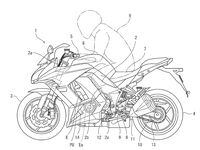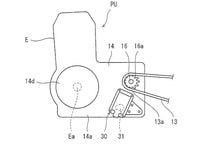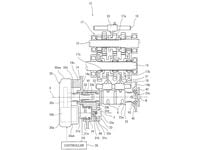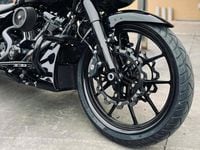A new patent has surfaced showing that Kawasaki has started to develop an electronically shifted transmission that might well be destined for a touring bike to replace its aging Concours 14 model, but could also benefit superbikes or even cruisers in the future. Semi-auto boxes have long been on the verge of widespread acceptance, with Honda finding success with its DCT dual-clutch transmissions since 2009 and Yamaha offering its FJR1300 with the YCC-S auto-shifting system as early as 2006. Now Kawasaki looks like it’s finally working on its own.
The Kawasaki system appears to be aimed at replicating the conventional gear-shifting experience when required, keeping the foot-operated lever but using an electronic actuator and sensors instead of a physical linkage between your left foot and the shift drum. The firm’s new patent uses the outline of a Ninja 1000 SX to illustrate its idea, but that doesn’t mean it’s the machine that will eventually benefit from the technology. In fact, despite the patent being newly published, with its original Japanese submission dating back to July 2019, the bike used for the illustration is the first-generation Ninja 1000 SX that was revealed back in 2010. It’s been updated and restyled twice since then, so the patent picture is almost certainly just a placeholder to ensure the design doesn’t give away any more secrets than absolutely necessary.
The patent focuses instead on a compact and simple electronic shift mechanism that translates the movement of the gear lever into a rotation of the shift drum. It means there’s no longer a need for a physical linkage, freeing up the bike’s packaging to allow the footpegs to be moved without having to worry about how the shifter will be operated. Whether you’ve got rearsets or highway pegs, the design means you only need an electric wire to connect the lever to the transmission.
With an actuator rotating the shift drum on the otherwise-conventional transmission, it’s easy to see how the system could be used on any number of bikes. Swapping the foot-operated lever for bar-mounted buttons would be simplicity itself, and with a computer between the rider and the gearshift it would be easy to make sure that false neutrals, over-revving, and mistimed gear changes were avoided. On sportbikes, the system would be able to do the same job as a quickshifter but potentially change ratios faster than your foot can move, tying in with the engine electronics to make sure that the revs are matched perfectly. Alternatively, it could easily be allied to an automated clutch for a fully or semi-auto transmission.
Where will the system appear first? That’s a tough call, but Kawasaki is known to be developing a new model with the Bosch radar-assisted cruise control system that’s already appeared on Ducati’s Multistrada V4 and BMW’s 2021 R 1250 RT. A tourer or adventure-tourer would be the most obvious recipient of such technology, and a long-distance machine like that might also be the ideal starting point for an electronically shifted gearbox.





/cloudfront-us-east-1.images.arcpublishing.com/octane/RGUT3Y65IFGDFMLHQ3U7G5UUQE.jpg)

/cloudfront-us-east-1.images.arcpublishing.com/octane/37CSHD6CKRHYXHRB67EOLDS6XM.jpg)
/cloudfront-us-east-1.images.arcpublishing.com/octane/FYB7GKDGLVE3JKXMM75JTG2RYA.jpg)
/cloudfront-us-east-1.images.arcpublishing.com/octane/3ECVMM622VAZHIOLI6Q6ILWULU.jpg)


/cloudfront-us-east-1.images.arcpublishing.com/octane/UIZQ7VXRCRHBVDFK5RFJIEBBAU.jpg)

/cloudfront-us-east-1.images.arcpublishing.com/octane/QXBJ4CVEEBG2BF5O3TOPIGP7ZE.jpg)


/cloudfront-us-east-1.images.arcpublishing.com/octane/HGNDJUKK4FHNTP5XEYYHWVW6NI.jpg)
/cloudfront-us-east-1.images.arcpublishing.com/octane/GDGQOIQBDBCXLIUZUEMCP2C5ZE.jpg)
/cloudfront-us-east-1.images.arcpublishing.com/octane/M6Z3IHJEAZE4XDQGCFN7YPJEOA.jpg)
/cloudfront-us-east-1.images.arcpublishing.com/octane/L6GYTNOQB5FOXPUZIQZYQSJ3PI.jpg)
/cloudfront-us-east-1.images.arcpublishing.com/octane/FCGZHQXRBZFLBAPC5SDIQLVF4I.jpg)
/cloudfront-us-east-1.images.arcpublishing.com/octane/CWPFD2XJ6VHSJK3YMIJGHRJ5SA.jpg)
/cloudfront-us-east-1.images.arcpublishing.com/octane/4TTNZVVO6ZGN7AQUHVGHM4NFLQ.jpg)
/cloudfront-us-east-1.images.arcpublishing.com/octane/RXDCXNV46VFEVM4FNKCBPCTQXE.jpg)
/cloudfront-us-east-1.images.arcpublishing.com/octane/IM3CJCUTHRHXFCJG77O4OCEBII.jpg)
/cloudfront-us-east-1.images.arcpublishing.com/octane/PHTL3AYR4NBHTDGG5IPVQLJJIQ.jpg)